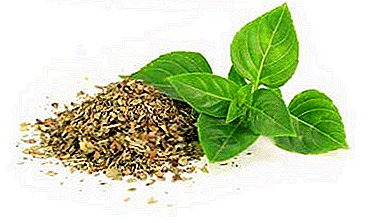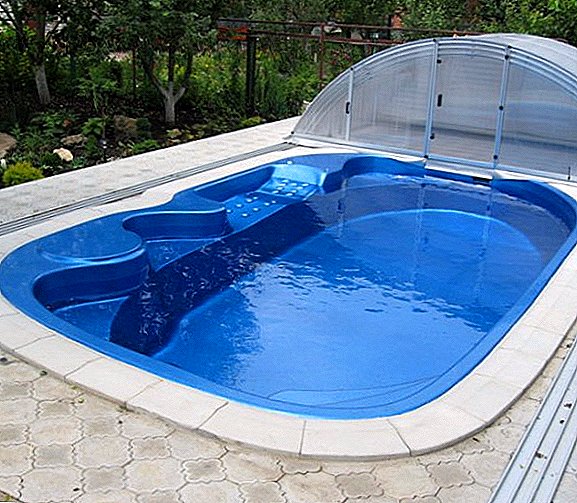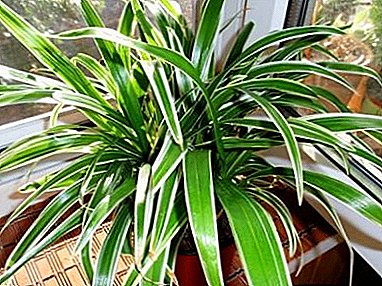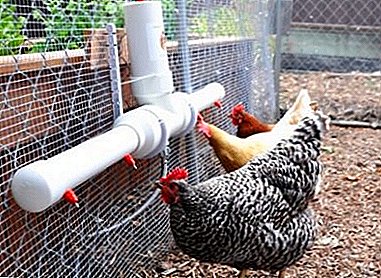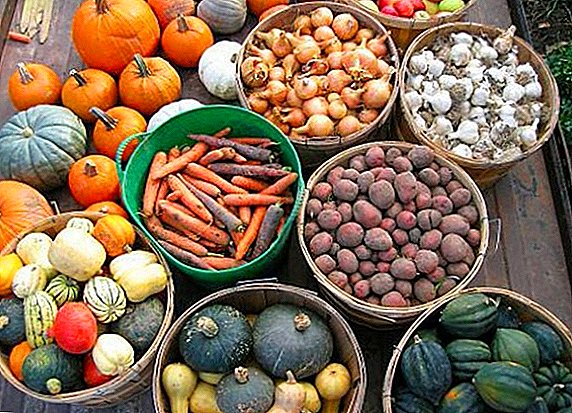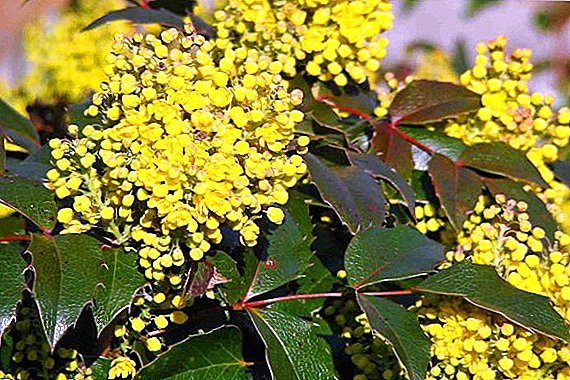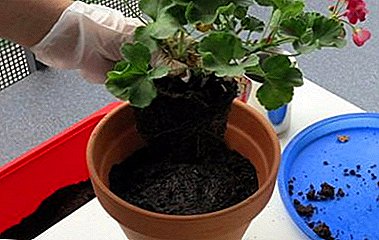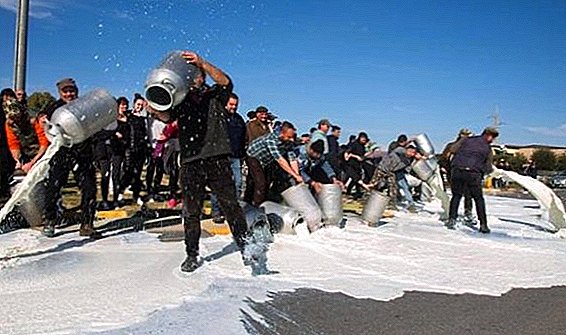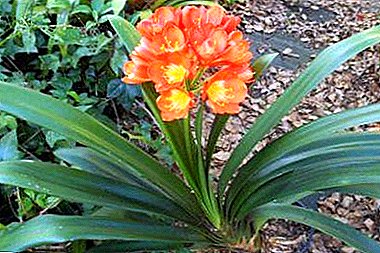
Kliviya miniata, the same Kaffir lily, is an exotic and thermophilic plant. You can meet kafir lily in nature on the territory of South Africa, namely in those parts of the evergreen forest where the soil is most nutritious.
She prefers to grow close to the source of moisture and rocky gorges. The botanist who worked for the Duchess Charlotte Clive decided to immortalize her name and named a flower in her honor.
In our latitudes brought Kliuviya in the 19th century, and it immediately won the hearts and love of all who saw it.
Description and features of the Kaffir lily
The flower reaches 45-50 cm tall. In the year he can release about 5-7 dark green leaves, resembling curved ribbons. Leaves grow one after another, thus forming a false stalk. The rhizome is not large, but the roots are quite thick and fleshy.
 Kaffir lily blooms twice a year:
Kaffir lily blooms twice a year:
- the first period lasts from February to early April;
- the second period - from the beginning of September to the end of November.
The inflorescence consists of 15-25 flowers and reaches 17-20 cm in diameter. The peduncle itself grows up to 20-30 cm tall. Inflorescence often has a bright orange, saturated color. After the flowering period is completed, the perianth falls and a trihedral, rounded ovary appears in its place.
After 1 - 1.5 weeks the fruit and seeds ripen. The fruit is initially dark green, and as it ripens it acquires a rich red color. Plant breeds were derived additional colors Clivia: dark orange and pale yellow.
We offer to read the description and get acquainted with the features of different types of clivia in this article.
How to care?
Temperature
How to grow Klivia to fully manifest its decorative effect? Properly set the temperature. He will help the plant to blossom in a timely manner and for a long time. The temperature at + 19-25 ° C should be in the period of clivia growth, and from September to March the temperature should be maintained in the region of + 13-16 ° C. When the temperature of the air drops from the flower and "peace" comes, during this period the Kaffir lily begins to form buds by the new season.
Lighting
The best place to grow Clivia is the western or eastern side of the house.. This flower loves a lot of diffused light, but direct sunlight is dangerous for it. During the summer season it is best to rearrange the Kaffir lily to the terrace.
If the windows of your house are facing the south, you should darken the cut slightly. Placing a flower on the north side is not recommended at all, growth will be slowed down, and flowering may not occur at all.
Humidity
You need to water the plant at the moment when you can see that the topsoil is already dry. Water is used when it is settled and, preferably, soft.
 If there is excess water in the pallet, it must be drained, due to transfusion, the roots of clivia will begin to rot, which will lead to her death.
If there is excess water in the pallet, it must be drained, due to transfusion, the roots of clivia will begin to rot, which will lead to her death.
The harshness of air humidity suggests that spraying a flower can be replaced by wiping leaves with a damp cloth.
These actions must be performed for hygienic purposes, i.e. for ridding the flower of the unwanted layer of dust.
During the flowering period, the number of waterings increases.. After flowering, the opposite is reduced to 1 time in 1.5-2 weeks.
Growing up
The plant has a lot of advantages, which attract all flower growers, namely: caring for cleavia at home is easy, it has been elegantly and continuously blooming for many years. Observing a few basic, simple rules on the content of this flower, the emergence of any difficulties can be completely eliminated.
How to make bloom?
The lack of flowering in clivia can be due to a number of the following reasons: a short rest period, inappropriate temperature for flowering, poor lighting and an excess of nitrogen in the soil.
Eliminate the reasons for the lack of flowering can be as follows:
- The dormant period for the formation of kidneys can be increased by moving the cleavia to a cooler room.
- The optimum temperature for flowering is up to + 13-16 ° C.
- It is necessary to rearrange the Kaffir lily to the place where it will receive the necessary amount of diffused light.
- If the top dressing consisted mainly of nitrogen-based, then it should be replaced with organic matter or potassium fertilizer.
After all the reasons for the lack of flowering are eliminated, the appearance of inflorescences will not keep you waiting long.
You can read more about why clivia doesn't bloom here.
What to do after the petals wilted?
 What to do with clivia peduncle after flowering? At the end of this period, dry, wilted flowers remain on the plant, which for a long time do not fall off and, with a slight mechanical effect, also do not crumble. That is why, being afraid of harming the plant, flower growers are wondering what to do with the peduncle when the clivia has blossomed? The answer is simple. It is necessary to arm with scissors and carefully cut the flowers.
What to do with clivia peduncle after flowering? At the end of this period, dry, wilted flowers remain on the plant, which for a long time do not fall off and, with a slight mechanical effect, also do not crumble. That is why, being afraid of harming the plant, flower growers are wondering what to do with the peduncle when the clivia has blossomed? The answer is simple. It is necessary to arm with scissors and carefully cut the flowers.
The main thing when pruning does not touch the shtamb. In case of damage, the plant is more vulnerable to diseases. When the Kaffir Lily has completely faded, and there is no need to wait for the fruits to ripen, then all the ovaries need to be cut off. You should wait until the stem of the inflorescence dries, and then carefully remove it from the leaves. A dry, withered stem is easily pulled out without harming the plant.
After flowering, clivia begins a period of rest, which means that it requires slight changes in care, namely:
- Reducing the number of watering.
- The exclusion of drafts.
- More frequent moistening by spraying or wiping with a damp cloth.
Do not feed the Kaffir lily in the dormant period, because it will be more depleting the plant.
Breeding
Clivia propagation can occur in two ways: vegetative and by obtaining seeds.
Vegetative method
Around the main plant with time appear "kids." It is forbidden to separate sprouts from the root during flowering..
At that moment, when 4 leaves appear in small lateral offspring, they can be separated from the rhizome of an adult plant.
Seeds
This method is less effective, but having a place to be. To plant the seeds of the Kaffir lily should be in the nutrient substrate at a distance of 3 cm from the other seed. The emergence of the shoot can be observed after 6 months. After the seedling releases several leaves, they must be transplanted into separate containers.
Learn more about the reproduction and cultivation of clivia from this article.
Transfer
 To transplant Kaffir lily is not difficult, for this:
To transplant Kaffir lily is not difficult, for this:
- The plant is watered abundantly so that the soil gets wet and it is easier to remove the root system from the old pot.
- The roots are washed with water and in the presence of rotted areas they must be carefully cut off.
- In the new tank you need to put a drainage, which will take a quarter of the pot in height. Next, drainage is filled with soil 3-4 cm and placed on top of cleavia. All voids must be filled with earth.
More details about the features of clivia transplantation can be here.
Diseases
Clivia is rarely affected by any disease. Such situations occur only in those cases if the conditions for growth were absolutely not suitable for the plant.
Yellow leaves
Most often the leaves begin to turn yellow when the root system is affected.. This situation can be remedied by cutting off the rotten and damaged roots of the plant, then placing the cleavia in fresh, new soil. Another factor affecting leaf color is a shortage or excess of fertilizers. Keep track of the frequency and amount of feeding.
In order not to infect the soil, it should be disinfected at the time of transplanting the flower.
Does not form buds
On the plant may appear such pests as: scale or mealybug. This can be determined by the appearance of dark spots or white "cotton" on the leaves. Until this problem is resolved, the flowering period may be delayed, because the plant does not receive enough nutrients at that moment. To get rid of the parasite of klivia, you can wipe the leaves with a solution on a soapy basis, with the addition of a small amount of alcohol.
Pests can not greatly affect flowering in the case of a mild stage of the disease. The main reason is improper care.
Toxicity and beneficial properties
 Despite the beauty of this flower, it is a poisonous plant. If you damage the leaves or roots, you can see the release of yellow juice, which contains toxic alkaloids. In the case of ingestion of a large amount of this substance, it leads to paralysis, and in some cases fatal. When alkaloids enter the body in small quantities, this leads to poisoning and excessive salivation.
Despite the beauty of this flower, it is a poisonous plant. If you damage the leaves or roots, you can see the release of yellow juice, which contains toxic alkaloids. In the case of ingestion of a large amount of this substance, it leads to paralysis, and in some cases fatal. When alkaloids enter the body in small quantities, this leads to poisoning and excessive salivation.
Do not place the pot with clevium in the nursery and in easily accessible places for animals. So you can protect them from possible danger.
The substances contained in the plant juice such as: klivatin and likorin allow the plant to be used in pharmacology. On the basis of clivia make drugs that contribute to the improvement of blood circulation.
After any treatment of leaves or root system clivia, be sure to thoroughly wash hands. Kaffir lily is perfect for any interior, and the unpretentiousness and beauty of this plant will give positive emotions for many years.
We offer to watch videos of Clivia plant and its care methods:


